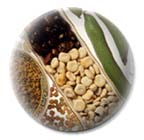
|
Vegetable Seed Production:
You are here: Seed Production: Malvaceae:
Okra
 |
Common Name: Okra
Scientific Name: Abelmoschus esculentus (L) Moench
Family: Malvaceae (Mallow Family) |
Botany
(At one time designated as Hibiscus exculentus.)
- Okra is sometimes called gumbo
- Okra is a warm-season annual dicot, relatively erect plant with many
short branches
- The plant is frost intolerant and does not grow well when temperatures
are below 60 degrees F
- Okra is in the same family as cotton and hibiscus
- Dwarf cultivars are less than one meter tall, others cultivars are
taller than 2 meters
- Okra leaves are large broad, heart shaped and lobed
- Flowers are large and showy with five yellow petals
- The flowers are perfect and self fertile
- One flower appears in each alternating leaf axil after the 6-8th
node
- Flowers are open once for only a short period during the day
- Seldom is more than one flower open on a given plant
- In the field, flowers are mostly cross-pollinated, can be self-pollinated
without yield problems
- The fruit is a long pod comprised of several fused carpels
- Most cultivars used for commerce are ribbed and spineless
- The developing pod and immature seeds are the edible portion
- Okra is harvested while immature and tender
- Pods of some cultivars are of satisfactory quality even when as large
as 15-20 cm in length and 2-3 cm. in diameter
- For optimum quality, the pods are harvested when much smaller, i.e.,
8-15 cm by 1-2 cm
- External pod colors range from white through pale to dark green.
- A cultivar with red coloration is available
Soil Nutrition
Okra is slightly
sensitive to soil acidity but generally soil pHs of 6.0 to 7.0 are
satisfactory. Fertilization rates vary dramatically with soil type and
should be calculated based on soil test results. Okra is considered a
heavy feeder and will and remove approximately 180 lbs/acre N, 30
lbs/acre phosphate, and 150 lbs/acre of K per season. Okra generally
responds well to fertilization when soil fertility is low. Side
dressings of N may be applied 2 weeks before harvest and again after
harvest has begun to stimulate additional vegetative growth.
Isolation
Recommended isolation distances vary from one country to another, but
a minimum isolation distance of 500 m is desirable.
Planting
In the southern US, okra is
generally direct seeded when soil temperatures exceed 60 degrees F. The
seed is planted thickly in rows spaced 2.5 to 4.0 feet part. When
plants are established they are thinned to an in-row spacing of 12
inches apart for dwarf cultivars and 18-24 inches for larger cultivars.
Okra seeds have hard seed coats an soaking seeds in hot water for 1-2
hours prior to planting improves germination. In northern areas okra is
sometimes transplanted but this is not an established practice for
large scale commercial production. Poor stand establishment can be a
problem when soil temperatures are cold or because of the hard seed
coats.
Irrigation
Okra plants have good
drought tolerance but yield is adversely affected when plants are water
stressed during flowering. During flowering and fruit development,
uniform soil moisture is essential. During flowering and fruit set
plants should receive at least 1.5 inch per week of water to ensure
fruit set and development. In western states, furrow irrigation is
used. In eastern states drip irrigation is gaining popularity because
it helps reduce foliage diseases and overhead irrigation are used as
needed.
Roguing
1. Before flowering
Check the general plant height and habit, pigmentation of leaves, petioles
and stems; remove plants with virus symptoms.
2. Flowering
Check the relative size and color intensity of flowers; remove plants
with virus symptoms.
3. Fruiting
Check that fruit is true to type; remove plants with virus symptoms.
|
Diseases |
Insect Pests |
Since okra is related to cotton, many of the pests are the same. Okra should not be rotated with cotton. Cotton diseases include:
- Root rot
- Pod rot
- Fusarium wilt
- Verticillium wilt
- Powdery mildew
- Dry rot
- Cercospera blight and leaf spot
- Alternaria leaf spot
|
- Boll weevil
- Pink boll worm
- Corn earworm
- Flea beetle
- Cotton aphid
- Stemborer
- Leafhopper
- Spidermite
- Whitefly
|
Seed Harvest
There is a sequential ripening of okra pods on a plant. The fruits of
the angular fruited types have a tendency to split when the seed ripens.
The maturity of seeds is associated with the pods becoming gray or brown
according to the cultivar.
The traditional hand harvesting of ripe pods is still done in many tropical
areas where there is adequate labor, although the crop is combined in
the
USA.
Cleaning
Seeds are extracted after the hand-harvested pods become dry and brittle.
The most efficient method of hand seed-extraction is to twist the pods
open. Alternatively the pods are either flailed or the seeds are extracted
with a stationary thresher.
In some areas of the world, especially Malaysia, the initial pods are
harvested as a fresh vegetable and the later pods are retained on the
plants for seed production. This practice probably does not reduce the
potential seed yield in areas with a sufficiently long growing season,
as removal of early pods tends to encourage further extension growth and
flower development.
Seed Yield
A relatively high seed yield of 1500 kg/ha (1,338 pounds per acre) is achieved in the okra seed producing areas of the USA but in many tropical countries the yield rarely exceeds 500 kg/ha (446 pounds per acre).
Seed Identification:
|
